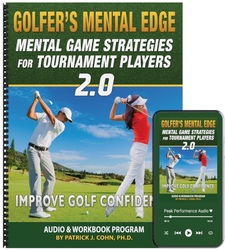How Do You Respond To A Bad Shot?
Are you frustrated or composed and ready for the next shot?
Too many golfers I work with sabotage their entire round by dwelling on the last shot, as if it’s natural for them and necessary to get upset…
If you are in this camp, your next few holes are a snowball effect of frustration and more bogeys.
How can you let go of the bad shot or hole?
It’s all about emotion and focus.
I interviewed Dr. Glen Albaugh regarding emotional management on the golf course.
Dr. Albaugh is a sports psychology consultant for many athletes including professional and amateur golfers.
Albaugh taught Sport Psychology at the University of Pacific for 28 years while also coaching the Pacific Tigers golf team.
Albaugh co-authored the insightful book, “Winning the Battle Within”, which details the effective mental approach for sports.
COHN: “Your teaching, reminds me a lot of this old catchphrase, ‘you’ve got to get out of your own way.’ Can you talk a little bit about that?”
ALBAUGH: “We call it the SAT, which is strategy, aim and trust. You’re approaching your shot and the first thing you do is stabilize your emotions…”
“Then you pick a strategy that fits the situation and fits your game. Pick something you can totally commit to, ‘I can do this shot.’”
“Next… as we walk into the shot… we see the shape of the shot, we see the target, and we align ourselves and with our waggles and our looks at the target, and that’s called aiming.”
“The last part is trusting; it’s swinging without conscious thought.”
Albaugh addressed how to respond after a missed shot using a post-shot routine.
ALBAUGH: “Sometimes we miss shots though, and now we have to review it and recall it and replace it and refocus. And we’ve got to do that within about 5 steps, so we’re ready to go… So you have pre-shot, post-shot, in between shot routine. Those are skills you have to practice so you’re able to execute those skills when you’re playing a competition.”
Try these tips to effectively manage your emotions while playing golf:
- Tip #1: Use your post-shot routine to let go of the last shot or hole. Rationalize with yourself that the shot is over and you can’t get it back. Commit to the next shot by focusing on your plan and aim, then turn off your thinking mind and trust your ability to make the shot.
- Tip #2: Practice the way you want to play including using your pre-shot, post-shot and in-between shot routines. Deal with your frustration during practice. Understand the most frustrating part about bad shots is how you react to them.
Related Sports Psychology Articles
- Helping Young Golfers Overcome Bad Shots
- How to Let Go of Bad Shots And Stay Composed
- How Do You React To Bad Shots?
*Subscribe to The Sports Psychology Podcast on iTunes
*Subscribe to The Sports Psychology Podcast on Spotify
Download a free sports psychology report to improve your mental game!
Learn more about our one-on-one mental game coaching.
Golfer’s Mental Edge

What’s the big sign that your mental game is the weak link in your golf game? When you can’t play consistently as well as when you play a practice or casual round–or your range game is way better than your game on the course. If you suffer from lack of focus, low self-confidence, poor composure or other mental game obstacles on the course, you can’t reach your true potential in golf.
The Golfer’s Mental Edge 2.0 Audio and Workbook program is ideal for any amateur, collegiate, junior, and tour professional golfer.
Golf coaches and instructors would also be wise to teach “The Golfer’s Mental Edge 2.0” principles to their players. This program is perfect for any golfer who wants to improve performance and consistency by managing their mind better on the course.


